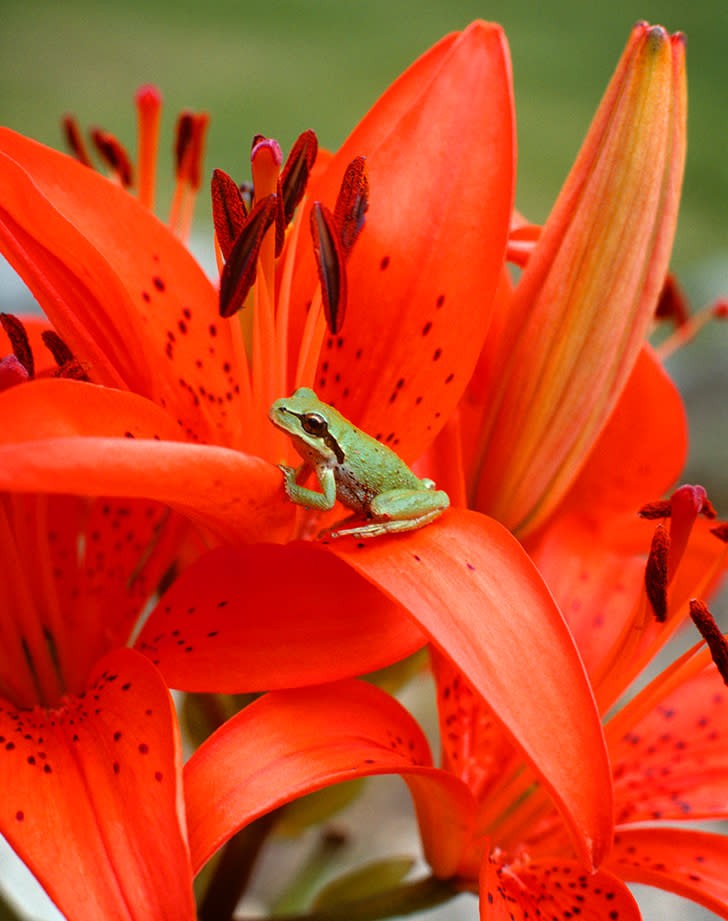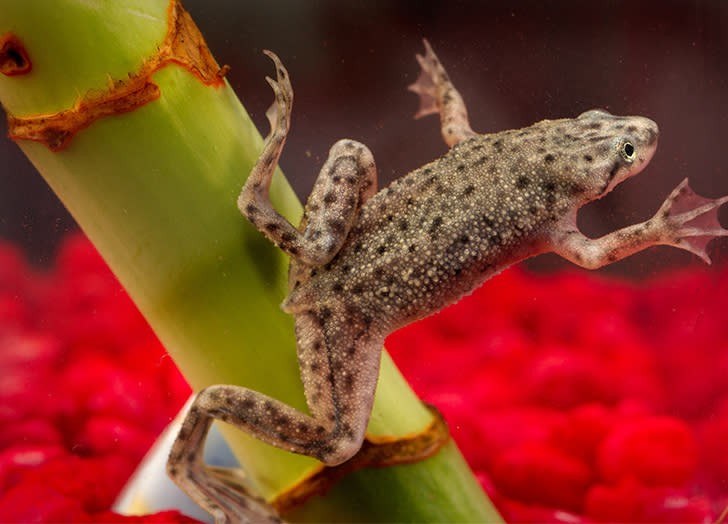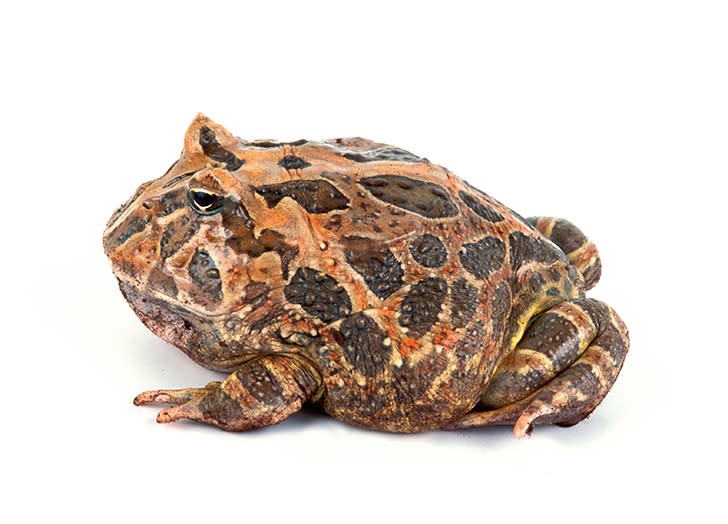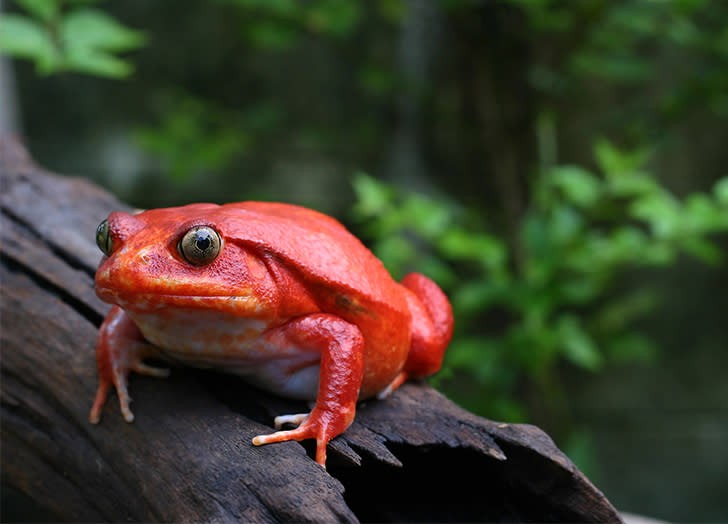Can You Have Frogs As Pets? Absolutely! Frogs can make fascinating and relatively low-maintenance pets, especially for those who appreciate observing rather than cuddling. This comprehensive guide from PETS.EDU.VN will explore everything you need to know about keeping frogs as pets, from selecting the right species to creating the ideal habitat and ensuring their health and well-being. Discover the joy of amphibian ownership and learn how to provide a fulfilling life for your new froggy friend, including detailed insights into frog care, amphibian ownership, and responsible pet ownership.
1. Understanding Frogs: An Introduction to Amphibian Companions
What are frogs? Frogs are amphibians, fascinating creatures known for their unique life cycle and diverse adaptations. As amphibians, they begin their lives in water, typically as tadpoles, and undergo metamorphosis to develop into land-dwelling adults. However, they still require moist environments to survive because they absorb water and air through their skin. With approximately 7,000 species worldwide, frogs exhibit a wide range of sizes, colors, and behaviors.
1.1 Frogs vs. Toads: What’s the Difference?
What are the key differences between frogs and toads? Toads are actually a type of frog, but not all frogs are toads. Both belong to the Anura order, characterized by the absence of tails in their adult stage. However, they differ in several key aspects:
- Skin: Frogs generally have smooth, moist skin, while toads have drier, bumpy skin.
- Legs: Frogs tend to have longer hind legs for jumping, while toads have shorter legs, making them better suited for walking or hopping.
- Habitat: Frogs typically live in or near water, whereas toads can thrive in drier, terrestrial environments.
Understanding these differences can help you choose the right amphibian pet and provide appropriate care.
1.2 Types of Frog Habitats: Arboreal, Terrestrial, and Aquatic
What are the different types of frog habitats? Frogs can be categorized based on their preferred habitats:
- Arboreal: Tree-dwelling frogs, like the American Green Tree Frog, require tall terrariums with branches and plants for climbing.
- Terrestrial: Land-dwelling frogs, such as the American Toad, need a terrarium with substrate for burrowing and a shallow dish of water.
- Aquatic: Water-dwelling frogs, like the African Dwarf Frog, spend most of their time in an aquarium.
Selecting a frog species whose habitat needs align with your lifestyle and available space is crucial for their well-being.
2. Considerations Before Getting a Pet Frog
2.1 Understanding Frog Behavior and Temperament
Are frogs good pets for children? Frogs can be excellent pets, especially for children who are interested in observing and caring for animals rather than cuddling them. It’s essential to understand that frogs are generally nocturnal, meaning they are most active at night. They are also not fond of being handled, so they are better suited for individuals who appreciate their unique characteristics from a distance.
2.2 The Ethical Considerations of Keeping Frogs as Pets
Is it ethical to keep frogs as pets? Keeping wild-caught frogs as pets is generally discouraged due to the potential for spreading diseases and disrupting ecosystems. Instead, it’s best to purchase frogs from reputable breeders who are members of organizations like the United States Association of Reptile Keepers (USARK). This ensures that you are acquiring a healthy, captive-bred frog that is better adapted to living in a terrarium or aquarium.
2.3 Legal Aspects of Owning a Pet Frog
Are there any legal restrictions on owning frogs? The legality of owning certain frog species can vary depending on your location. Some species may be protected or require permits to own. Always check local and state regulations before acquiring a pet frog to ensure compliance with the law.
3. Top 10 Frog Species to Consider as Pets
What are the best frog species to keep as pets? Here are ten frog species that are popular choices for pet owners, along with their specific care requirements:
3.1 African Dwarf Frog (Hymenochirus boettgeri)
What are the care requirements for African Dwarf Frogs? These small, fully aquatic frogs are relatively easy to care for and can be housed in a community aquarium with peaceful fish. They require a 10-gallon or larger tank with a secure lid, a water temperature of 72-80°F, and a diet of frog pellets, bloodworms, or brine shrimp.
| Aspect | Details |
|---|---|
| Size | 1.25-2 inches long |
| Color | Gray, black, or olive green |
| Habitat | 10+ gallon aquarium, 12” tall |
| Care | Moderate maintenance |
| Temperature | 72-80 degrees |
| Diet | Frog/tadpole pellets, fish food, worms |
| Life Expectancy | 5 years |
| Price | $2-$5 |




3.2 American Green Tree Frog (Hyla cinerea)
What are the care requirements for American Green Tree Frogs? Native to the United States, these bright green frogs are arboreal and require a tall terrarium with plenty of climbing opportunities. They thrive in temperatures of 70-80°F and eat a diet of crickets and other insects.
| Aspect | Details |
|---|---|
| Size | 1-2.5 inches long |
| Color | Bright green |
| Habitat | Minimum 24”-tall terrarium |
| Care | Low-maintenance |
| Temperature | 70-80 degrees |
| Diet | Crickets |
| Life Expectancy | 2-6 years |
| Price | $10 |
3.3 American Toad (Anaxyrus americanus)
What are the care requirements for American Toads? These terrestrial toads are hardy and easy to care for, making them a great choice for beginners. They require a 10-gallon terrarium with a shallow water dish, a temperature of 60-70°F, and a diet of insects and toad pellets.
| Aspect | Details |
|---|---|
| Size | 3 inches long |
| Color | Brown |
| Habitat | 10-gallon terrarium |
| Care | Low-Maintenance |
| Temperature | Room temperature |
| Diet | Insects, toad pellets |
| Life Expectancy | 15-20 years |
| Price | $10 |
3.4 Gray Tree Frog (Hyla versicolor)
What are the care requirements for Gray Tree Frogs? Found in the U.S. and Canada, these frogs are known for their ability to change color to match their surroundings. They require a moderately sized terrarium with ample humidity and a temperature of 65-80°F. Their diet consists of insects.
| Aspect | Details |
|---|---|
| Size | 1.25–2.25 inches long |
| Color | Gray, green |
| Habitat | 18”-tall terrarium |
| Care | Moderate maintenance |
| Temperature | 65-80 degrees |
| Diet | Insects |
| Life Expectancy | 7-9 years |
| Price | $8–$20 |
3.5 Oriental Fire-Bellied Toad (Bombina orientalis)
What are the care requirements for Oriental Fire-Bellied Toads? These colorful amphibians require a semi-aquatic habitat with both land and water areas. They thrive in temperatures of 65-82°F and eat a diet of insects. A UVB light is recommended if they cannot be placed near a sunny window.
| Aspect | Details |
|---|---|
| Size | 2-3 inches long |
| Color | Green with red, orange, or yellow bellies |
| Habitat | 10-gallon aquarium (half water, half land) |
| Care | Moderate maintenance |
| Temperature | 65-82 degrees |
| Diet | Insects |
| Life Expectancy | 10 years |
| Price | $5-$25 |
3.6 Pacman Frog (Ceratophrys ornata)
What are the care requirements for Pacman Frogs? Also known as South American Horned Frogs, these large, round frogs are known for their voracious appetites. They require a 10-gallon terrarium with a substrate deep enough for burrowing, a temperature of 75-85°F, and a diet of insects.
| Aspect | Details |
|---|---|
| Size | Up to 8 inches long |
| Color | Various |
| Habitat | 10-gallon terrarium |
| Care | Low maintenance |
| Temperature | 75-85 degrees |
| Diet | Insects |
| Life Expectancy | 7-10 years |
| Price | $20-$40 |
3.7 Pixie Frog (Pyxicephalus adspersus)
What are the care requirements for Pixie Frogs? These large African bullfrogs can grow to be quite large, with males reaching up to two pounds. They require a 20-gallon aquarium with a temperature of 75°F and a diet of large insects and small rodents.
| Aspect | Details |
|---|---|
| Size | 3.5-10 inches long |
| Color | Olive green |
| Habitat | 20-gallon aquarium |
| Care | Low maintenance |
| Temperature | 75 degrees |
| Diet | Large insects, rodents |
| Life Expectancy | 20 years |
| Price | $25-$75 |
3.8 South American Red-Belly Toad (Melanophryniscus moreirae)
What are the care requirements for South American Red-Belly Toads? Also known as Bumble Bee Toads, these small, colorful toads are relatively easy to care for. They require a 5-gallon terrarium with a shallow water dish, a temperature of 70-75°F, and a diet of small insects.
| Aspect | Details |
|---|---|
| Size | 1.5 inches long |
| Color | Black with yellow spots |
| Habitat | 5-gallon terrarium |
| Care | Low maintenance |
| Temperature | 70-75 degrees |
| Diet | Small insects |
| Life Expectancy | 10+ years |
| Price | $60–$90 |
3.9 Tomato Frog (Dyscophus antongilii)
What are the care requirements for Tomato Frogs? Native to Madagascar, these bright red-orange frogs are nocturnal and prefer to burrow. They require a 10-20 gallon terrarium with a temperature of 65-85°F and a diet of insects.
| Aspect | Details |
|---|---|
| Size | 2.5-4 inches long |
| Color | Red-orange |
| Habitat | 10-20-gallon terrarium |
| Care | Low maintenance |
| Temperature | 65-85 degrees |
| Diet | Insects |
| Life Expectancy | 8 years |
| Price | $20-$50 |
3.10 White’s Tree Frog (Litoria caerulea)
What are the care requirements for White’s Tree Frogs? Also known as Dumpy Tree Frogs, these docile frogs are known for their laid-back nature and can tolerate handling. They require a 15-gallon terrarium with plenty of climbing opportunities, a temperature of 75-85°F, and a diet of insects.
| Aspect | Details |
|---|---|
| Size | 3-4.5 inches long |
| Color | Silver-green |
| Habitat | 15-gallon terrarium |
| Care | Low maintenance |
| Temperature | 75-85 degrees |
| Diet | Insects |
| Life Expectancy | 12-20 years |
| Price | $35-$80 |
4. Setting Up the Perfect Frog Habitat
4.1 Terrarium vs. Aquarium: Choosing the Right Enclosure
What type of enclosure is best for a pet frog? The choice between a terrarium and an aquarium depends on the frog species. Terrestrial and arboreal frogs thrive in terrariums, which provide a land-based environment with opportunities for climbing and burrowing. Aquatic frogs, on the other hand, require an aquarium filled with water.
4.2 Substrate: Creating a Natural and Safe Environment
What is the best substrate for a frog terrarium? The substrate is the material that lines the bottom of the enclosure, acting as natural ground for your frog. Suitable options include coco-husk fiber and moss. Avoid using gravel or pebbles, as these can be ingested and cause health problems.
4.3 Heating and Lighting: Maintaining Optimal Temperatures
How do I maintain the correct temperature for my pet frog? Since amphibians cannot regulate their own body temperatures, it’s crucial to provide supplemental heating and lighting. Heat pads or specialized lighting can be used to maintain the ideal temperature range for your frog species. Always monitor the temperature with a thermometer to ensure it stays within the appropriate range.
4.4 Humidity: Creating a Moist and Comfortable Environment
How do I maintain the correct humidity for my pet frog? Many frog species require high humidity levels to thrive. Regular misting with a spray bottle can help maintain the necessary humidity. A hygrometer can be used to monitor the humidity levels in the enclosure.
4.5 Decor and Enrichment: Providing Hiding Spots and Climbing Opportunities
What kind of decor is best for a frog terrarium? Providing ample hiding spots and climbing opportunities is essential for your frog’s well-being. Add logs, rocks, plants (live or fake), and other decor to create a stimulating and enriching environment.
5. Frog Nutrition and Diet
5.1 What Do Frogs Eat? A Guide to Feeding Your Amphibian
What should I feed my pet frog? Frogs primarily eat insects, such as crickets, mealworms, flies, and grubs. Larger frog species may also eat small rodents. It’s important to provide a varied diet to ensure your frog gets all the necessary nutrients.
5.2 Supplementation: Ensuring a Balanced Diet
Do frogs need supplements? Since captive frogs may not have access to the same variety of insects as they would in the wild, supplementation is often necessary. Dusting insects with calcium and vitamin supplements once a week can help ensure your frog gets a balanced diet.
5.3 Feeding Frequency: How Often Should You Feed Your Frog?
How often should I feed my pet frog? The frequency of feeding depends on the frog species and its size. Generally, young frogs need to be fed daily, while adult frogs can be fed every other day or a few times a week.
6. Health and Wellness of Pet Frogs
6.1 Common Health Issues in Pet Frogs
What are some common health problems in frogs? Like any pet, frogs can be susceptible to certain health issues. Some common problems include:
- Red Leg Syndrome: A bacterial infection that causes redness and swelling of the legs.
- Fungal Infections: Skin infections caused by fungi.
- Parasites: Internal or external parasites that can cause a variety of health problems.
- Metabolic Bone Disease (MBD): A condition caused by calcium deficiency.
6.2 Recognizing Signs of Illness
How can I tell if my frog is sick? Recognizing the signs of illness in your frog is crucial for early detection and treatment. Some common signs of illness include:
- Lethargy: Lack of energy or activity.
- Loss of Appetite: Refusal to eat.
- Abnormal Skin Appearance: Redness, swelling, or lesions.
- Difficulty Breathing: Gasping or wheezing.
- Abnormal Behavior: Unusual hiding or reluctance to move.
6.3 Preventative Care: Maintaining a Healthy Frog
How can I keep my frog healthy? Preventative care is essential for maintaining a healthy frog. This includes:
- Maintaining a Clean Habitat: Regular cleaning and water changes.
- Providing a Balanced Diet: Feeding a varied diet with appropriate supplementation.
- Monitoring Temperature and Humidity: Ensuring optimal environmental conditions.
- Regular Veterinary Checkups: Taking your frog to a qualified veterinarian for regular checkups.
6.4 Finding a Qualified Veterinarian
How do I find a vet who specializes in frogs? Finding a veterinarian who specializes in amphibians can be challenging, but it’s essential for providing the best possible care for your frog. Ask your local reptile or amphibian society for recommendations, or search online directories of exotic animal veterinarians.
7. Handling and Safety
7.1 Can You Cuddle Your Pet Frog?
Is it safe to handle frogs? While some frog species can tolerate handling, it’s important to do so gently and infrequently. Always wash your hands thoroughly before and after handling a frog to prevent the transfer of harmful substances or pathogens.
7.2 Safe Handling Techniques
What is the best way to hold a frog? When handling a frog, gently nudge it into your flat palm rather than plucking it off a surface. Hold it close to the ground in case it jumps or falls.
7.3 Potential Risks and Precautions
Are there any health risks associated with handling frogs? Frogs can secrete toxins that can be harmful if ingested or come into contact with the eyes. Some frogs also carry Salmonella bacteria. Always wash your hands thoroughly after handling a frog, even if you wore gloves.
8. The Joys and Responsibilities of Frog Ownership
8.1 The Benefits of Keeping Frogs as Pets
What are the benefits of owning a frog? Keeping frogs as pets can be a rewarding experience. They are fascinating creatures to observe, and their care requirements are relatively low compared to other pets. Owning a frog can also teach children about responsibility and the importance of caring for animals.
8.2 The Responsibilities of Frog Ownership
What are the responsibilities of owning a frog? Owning a frog is a commitment that requires time, resources, and dedication. You are responsible for providing a safe, healthy, and enriching environment for your frog, as well as ensuring it receives proper veterinary care.
8.3 Long-Term Commitment
How long do pet frogs live? Some frog species can live for many years, so it’s important to be prepared for a long-term commitment. Before acquiring a pet frog, consider whether you are willing and able to provide for its needs for the duration of its life.
9. Finding and Purchasing Your Pet Frog
9.1 Choosing a Reputable Breeder or Supplier
Where can I buy a pet frog? When purchasing a pet frog, it’s important to choose a reputable breeder or supplier who prioritizes the health and well-being of their animals. Look for breeders who are members of organizations like USARK and who can provide detailed information about the frog’s history and care requirements.
9.2 What to Look for When Selecting a Frog
How do I choose a healthy frog? When selecting a frog, look for signs of good health, such as:
- Clear, bright eyes
- Smooth, moist skin
- Good body condition
- Active and alert behavior
- No signs of injury or illness
9.3 Cost of Owning a Pet Frog
How much does it cost to keep a frog as a pet? The cost of owning a pet frog can vary depending on the species and its care requirements. Initial costs may include the purchase of the enclosure, substrate, heating and lighting equipment, and decor. Ongoing costs may include food, supplements, and veterinary care.
10. Frequently Asked Questions (FAQ) About Keeping Frogs as Pets
10.1 Are frogs good pets for beginners?
What kind of frogs are good for beginners? Yes, some frog species, such as American Toads and White’s Tree Frogs, are relatively easy to care for and make good pets for beginners.
10.2 Do frogs need a lot of space?
How much space do frogs need? The amount of space a frog needs depends on its size and activity level. Some small frog species can thrive in a 10-gallon terrarium, while larger species may require a 20-gallon or larger enclosure.
10.3 Can frogs live with other frogs?
Can frogs live together in the same tank? Some frog species are solitary and should be housed alone, while others can be kept in groups. Research the specific needs of your frog species before housing them together.
10.4 Do frogs need sunlight?
Do frogs need a special light to live? While frogs don’t necessarily need direct sunlight, they do need a light cycle to regulate their behavior. Some frog species also require UVB lighting for proper calcium absorption.
10.5 How often do frogs need to be fed?
How often should I feed my frog? The frequency of feeding depends on the frog species and its size. Young frogs need to be fed daily, while adult frogs can be fed every other day or a few times a week.
10.6 Do frogs need water?
Do frogs need water to survive? Yes, all frogs need access to water for hydration and bathing. Aquatic frogs spend most of their time in water, while terrestrial frogs need a shallow water dish in their terrarium.
10.7 Can frogs be trained?
Can frogs be trained like cats and dogs? While frogs cannot be trained in the same way as dogs or cats, they can be conditioned to associate certain cues with feeding or other activities.
10.8 What do I do if my frog escapes?
What to do if a frog escapes its tank? If your frog escapes, search the area thoroughly. Frogs need moisture to survive, so look in damp places like bathrooms and kitchens.
10.9 Are frogs expensive pets?
How much does it cost to take care of a frog? The cost of owning a pet frog can vary depending on the species and its care requirements. Initial costs may include the purchase of the enclosure, substrate, heating and lighting equipment, and decor. Ongoing costs may include food, supplements, and veterinary care.
10.10 Where can I learn more about frog care?
Where can I find more information about pet frog care? You can learn more about frog care from books, websites, and reptile and amphibian societies. PETS.EDU.VN is also a great resource for comprehensive and reliable information.
Conclusion: Embracing the World of Pet Frogs with PETS.EDU.VN
Keeping frogs as pets can be a rewarding experience for those who appreciate these fascinating amphibians. By understanding their unique needs and providing proper care, you can ensure a happy and healthy life for your froggy companion. Remember to source your frog from a reputable breeder, create an appropriate habitat, provide a balanced diet, and seek veterinary care when needed.
Are you ready to embark on your frog-keeping journey? PETS.EDU.VN offers a wealth of information and resources to help you succeed. From detailed care guides to expert advice, we’re here to support you every step of the way.
Ready to dive deeper?
- Explore our extensive library of articles on frog care and other exotic pets.
- Connect with our community of experienced frog keepers for tips and advice.
- Find trusted breeders and suppliers in your area.
- Learn about the latest advancements in amphibian health and wellness.
At PETS.EDU.VN, we’re passionate about helping you provide the best possible care for your pet frog. Visit our website today to unlock a world of knowledge and support!
For further assistance, contact us:
Address: 789 Paw Lane, Petville, CA 91234, United States
WhatsApp: +1 555-987-6543
Website: PETS.EDU.VN
Start your adventure in amphibian care with confidence – because every pet deserves a happy, healthy life! Begin your exploration of frog ownership at PETS.EDU.VN today, and ensure your pet thrives with the best care and information available. Discover the enchanting world of frog keeping and create a vibrant, healthy environment for your amphibian friend. Join the pets.edu.vn community and unlock the secrets to successful and joyful frog ownership.
